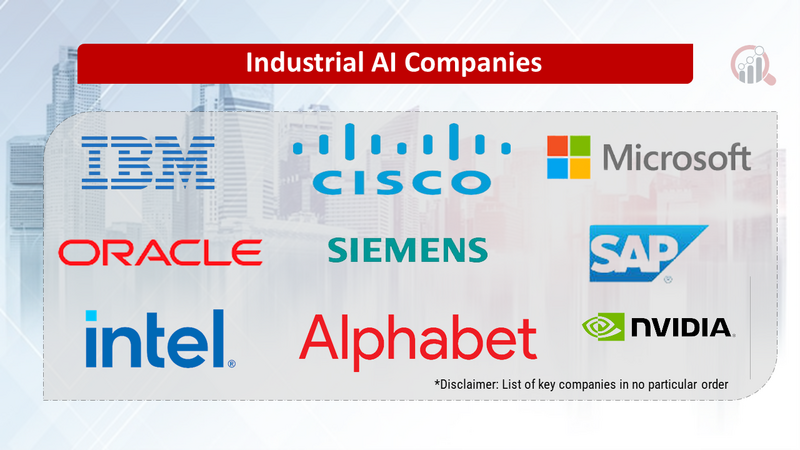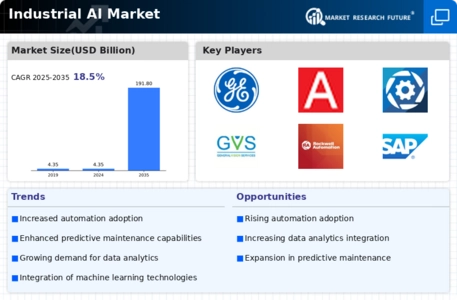Top Industry Leaders in the Industrial AI Market

Industrial AI Market: Dive into the Latest News and Updates
The industrial sector is undergoing a paradigm shift, propelled by the integration of Artificial Intelligence (AI). From optimizing manufacturing processes to streamlining predictive maintenance, Industrial AI is revolutionizing operations and fueling significant growth.
Some of Industrial AI Companies Listed Below:
- Siemens AG
- Nvidia Corporation
- Intel Corporation
- Alphabet Inc
- IBM corporation
- Microsoft Corporation
- General Electric
- Progress Software Corporation
- Sight Machine
- General Vision Inc
- AIbrain
- Rockwell Automation Inc
- Cisco Systems Inc
- Oracle Corporation
- SAP SE
Strategies Driving Market Share Growth:
-
Data Acquisition and Infrastructure: Building partnerships for data access, investing in robust data infrastructure, and ensuring data security are crucial for developing reliable AI models. -
Domain Expertise and Industry Focus: Understanding specific industry pain points and tailoring AI solutions to address them creates value and competitive differentiation. -
Partnership and Ecosystem Building: Collaborating with technology partners, industrial players, and startups fosters innovation and facilitates solution customization for diverse needs. -
Usability and User Experience: Prioritizing user-friendly interfaces, interpretable model outputs, and integration with existing systems maximizes adoption and user satisfaction.
Factors Influencing Market Share Analysis:
-
Technology Maturity and Performance: The accuracy, scalability, and explainability of AI models directly impact their effectiveness and influence market adoption. -
Target Industry and Use Cases: Focusing on high-value applications like predictive maintenance, process optimization, and quality control in diverse industries drives market growth. -
Data Privacy and Security: Implementing robust data security measures, ensuring data governance, and complying with industry regulations are essential for trust and market acceptance. -
Cost and Return on Investment: Demonstrating clear value proposition and tangible ROI through operational improvements is crucial for convincing industrial players to invest.
Emerging Companies and Innovation Trends:
-
Focus on Edge Computing and On-Premises Solutions: Deploying AI models on-site or at the edge addresses data privacy concerns and latency issues in specific industrial settings. -
Low-Code/No-Code AI Tools: Empowering domain experts with user-friendly AI development tools fosters in-house innovation and customization to specific needs. -
Integration with Robotics and Automation: Combining AI with robots and autonomous systems enables intelligent automation and advanced decision-making within production lines.
Current Investment Trends:
-
Venture Capital Funding: Innovative startups developing specialized AI solutions, user-friendly tools, and industry-specific applications are attracting significant venture capital funding, fueling market growth and innovation. -
Strategic Investments by Large Players: Established industrial players and technology giants are investing in promising startups and acquiring niche AI capabilities to strengthen their offerings and gain market share. -
Government Initiatives and Funding: Governments in developed economies are supporting industrial AI adoption through grants and subsidies, accelerating market development in specific regions.
Latest Company Updates:
-
Siemens and NVIDIA Announce Partnership (January 2024): The two companies are collaborating to develop industrial AI solutions for the manufacturing and healthcare industries, leveraging Siemens' domain expertise and NVIDIA's AI computing power. -
ABB Launches AI-Powered Robot Inspection System (December 2023): The system uses AI and computer vision to automatically inspect robots for defects, improving safety and uptime. -
Honeywell Unveils Predictive Maintenance Solution (November 2023): The solution uses AI to analyze sensor data and predict equipment failures before they happen, reducing downtime and maintenance costs.









